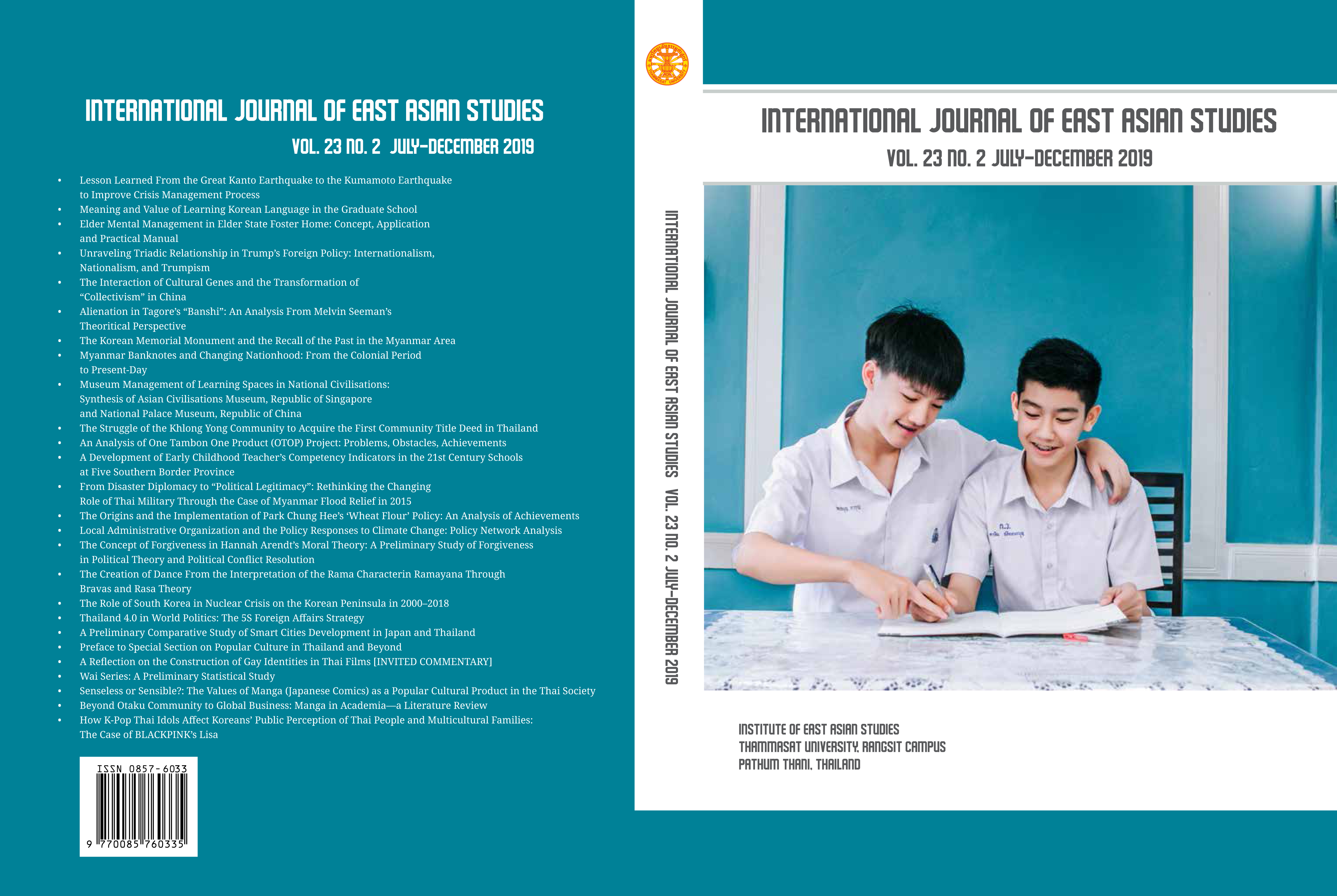A Development of Early Childhood Teacher’s Competency Indicators in the 21st Century Schools at Five Southern Border Provinces
Keywords:
develop indicators, early childhood teacher’s teaching competency, 21st centuryAbstract
The purposes of research were to (a) Study the factors of early childhood teacher’s teaching competency in the 21st century in 5 southern border provinces and (b) Develop indicators of early childhood teacher’s teaching competency in the 21st century in 5 southern border provinces. The samples involved 1,689 early childhood teachers in 5 southern border provinces in academic year 2018. 898 samples were used for exploratory factor analysis (EFA) and 791 samples were used for confirmatory factor analysis (CFA), selected by stratified random sampling. The research instrument was the questionnaire concerned early childhood teacher’s teaching competency in the 21st century. The face validity (IOC) of 51 items of questionnaire were between 0.66 - 1.00, the discrimination were between 0.53 - 0.91 and reliability with high value of Cronbach alpha coefficient 0.97. Data were analyzed for exploratory factor analysis (EFA) and confirmatory factor analysis (CFA).
The results were found that: (a) Results from the exploratory factor analysis (EFA) indicated that 7 factors of early childhood teacher’s teaching competency in the 21st century in 5 southern border provinces, were (1) Content and constructionist (2) Computer (ICT) Integration (3) Connectivity (4) Collaboration (5) Communication (6) Creativity, and (7) Caring. All 7 factors accounted for 70.21 percent of the total variance and the Eigen value were between 1.08 - 22.87; (b) Results from the confirmatory factor analysis (CFA) indicated that the measurement model of indicators of early childhood teacher’s teaching competency in the 21st century in 5 southern border provinces was a good fit with the empirical data (= 840.660, df = 731, p = .065, = 1.150, RMSEA = .014, NFI = .997, NNFI = .998, CFI = .997, RMR = .016, SRMR = .016, GFI = .964, AGFI = .960, = .988 และ = .617). The factors loading of early childhood teacher’s teaching competency in the 21st century in 5 southern border provinces indicated between .61 – .97. Ordered from high to low were Communication (= 0.97), Collaboration (= 0.93) Creativity (= 0.91), Content and constructionist (= 0.88), Connectivity (= 0.85), Computer (ICT) Integration (= 0.64) and Caring (= 0.61). Each indicators of each factors indicated the factors loading between .57 - .91 All factors loading were significant at the .01 level.
Downloads
References
กุญช์ภัสส์ พงษ์พานิชย์. (2561). การวิเคราะห์องค์ประกอบและตัวบ่งชี้สมรรถนะด้านการจัดการเรียนการสอนของครูผู้สอนนักเรียนระดับปฐมวัยที่ใช้ภาษาไทยเป็นภาษาที่สอง. วารสารมหาวิทยาลัยราชภัฏยะลา, 13(1), 1-12.
ฉัตรชัย หวังมีจงมี. (2560). สมรรถนะของครูไทยในศตวรรษที่ 21: ปรับการเรียนเปลี่ยนสมรรถนะ. Journal of HR intelligence, 12(2), 47-63.
ถนอมพร เลาหจรัสแสง. (2556). ทักษะแห่งศตวรรษที่ 21 เพื่อการพัฒนาอาจารย์ของมหาวิทยาลัยเชียงใหม่. เชียงใหม่: มหาวิทยาลัยเชียงใหม่.
ธเนศ ขำเกิด. (2555). สมรรถนะเฉพาะและตัวบ่งชี้ของครูปฐมวัย. สืบค้นเมื่อ 20 มกราคม 2561 จาก https://www.gotoknow.org/posts/77323
นฤตย์รำภา ทรัพย์ไพบูลย์. (2556). การพัฒนาตัวแบบการสร้างเสริมสมรรถนะครูปฐมวัย สังกัดองค์กรปกครองส่วนท้องถิ่น. วารสารวิชาการ คณะบริหารธุรกิจ, 8(1), 177-195.
พิมพันธ์ เตชะคุปต์. (2558). การจัดการเรียนรู้ในศตวรรษที่ 21 (พิมพ์ครั้งที่ 2). กรุงเทพฯ: โรงพิมพ์แห่งจุฬาลงกรณ์มหาวิทยาลัย.
รวี ศิริปริชยากร. (2560). การพัฒนาคุณลักษณะครูปฐมวัยมืออาชีพในศตวรรษที่ 21 ตามหลักสมรรถนะครูผ่านการจัดการเรียนรู้ด้วยโครงงาน (Project-based Learning). กรุงเทพฯ: มหาวิทยาลัยสวนดุสิต.
รุ่งนภา จิตรโรจนรักษ์. (2556). เปิด 6 อุปสรรคการทำงานครูไทย สอนหนัก ขาดจิตวิญญาณ ไร้ทักษะ ICT. สืบค้นเมื่อ 20 มกราคม 2561 จาก http://www.enn.co.th/5942
สมาคมอนุบาลศึกษาแห่งประเทศไทย. (2561). 4 วิกฤติเด็กปฐมวัย เจาะลึกให้เข้าใจ ป้องกัน แก้ไขให้เท่าทัน. สืบค้นเมื่อ 20 มกราคม 2561 จาก http://www.preschool.or.th/
สิริมา ภิญโญอนันตพงษ์. (2553). การวัดและประเมินแนวใหม่: เด็กปฐมวัย. กรุงเทพฯ: ดอกหญ้าวิชาการ.
อัญชลี จันลา. (2559). ครูปฐมวัยกับการพัฒนาเด็กปฐมวัยสู่ศตวรรษที่ 21. สืบค้นเมื่อ 20 มกราคม 2561 จาก https://www.gotoknow.org/posts/619281
Translated Thai References
Phongphanit, K. (2018 [2561]) Kan Wikhro Ongprakop Lae Tua Bongchi Samatthana Dan Kan Chat Kanriankanson Khong Khru Phuson Nakrian Radap Pathommawai Thi Chai Phasa Thai Pen Phasa Thi Song. Warasan Mahawitthayalai Ratchaphat Yala , 13(1), 1-12.
Vangmeejongmee, C. (2017 [2560]). Samatthana Khong Khru Thai Nai Satawat Thi 21: Prap Kan Rian Plian Samatthana. Journal of HR intelligence, 12(2), 47-63.
Laohajaratsang, T. (2013 [2556]). Thaksa Haeng Satawat Thi 21 Phuea Kan Phatthana Achan
Khong Mahawitthayalai Chiang Mai. Chiang Mai: Mahawitthayalai Chiang Mai.
Khunkerd, T. (2012 [2555]). Samatthana Chapho Lae Tua Bongchi Khong Khru Pathommawai. Retrieved January 20, 2018 from https://www.gotoknow.org/posts/77323.
Suppaibool, N. (2013 [2556]). Kan Phatthana Tua Baep Kan Sangsoem Samatthana Khru Pathommawai Sangkat Ongkon Pokkhrong Suanthongthin. Warasan Wichakan Khana Borihan Thurakit, 8(1), 177-195.
Dechakup, P. (2015 [2558]). Kan Chatkan Rianru Nai Satawat Thi 21 (Phim Khrang Thi 2). Krungthep: Rong Phim Haeng Chulalongkon Mahawitthayalai.
Siriprichayakorn, R. (2017 [2560]). Kan Phatthana Khunnalaksana Khru Pathommawai Mue Achip Nai Satawat Thi 21 Tam Lak Samatthana Khru Phan Kan Chatkan Rianru Duai Khrong Ngan (Project-based Learning). Krungthep: Mahawitthayalai Suan Dusit.
Chitrotchanarak, R. (2013 [2556]). Poet 6 Upasak Kan Thamngan Khru Thai Son Nak Khat Chit Winyan. Retrieved January 20, 2018, from http://www.enn.co.th/5942
Samakhom Anuban Sueksa Haeng Prathet Thai. (2018 [2561]). 4 Wikrit Dek Pathommawai Cho Luek Hai Khaochai Pongkan Kaekhai. Retrieved January 20, 2018, from http://www.preschool.or.th/
Pinyoanuntapong, S. (2010 [2553]). Kan Wat Lae Pramoen Naeo Mai: Dek Pathommawai. Krungthep: Dok Ya Wichakan.
Chanla, A. (2016 [2559]). Khru Pathommawai Kap Kan Phatthana Dek Pathommawai Su Satawat Thi 21. Retrieved January 20, 2018, from https://www.gotoknow.org/posts/619281.
เอกสารภาษาอังกฤษ
Bureau of the Education Testing. (2011). The Quality Assessment Standards Kindergarten Education for Quality Assurance in School. Bangkok: Krusapa Printer.
Kim, J. O., & Mueller, C. W. (1978). Factor Analysis Statistical Methods and Practical Issues. Beverly Hills, CA: Sage.
Morrison, G. S. (2014). Fundamentals of Early Childhood Education (7th Ed). New Jersey: Pearson Education.
Wiratchai, N. (2008). Evaluation indicator Development. The First Open Moral Conference,
September 29, 2008. Bangkok: Ambassador Hotel.



